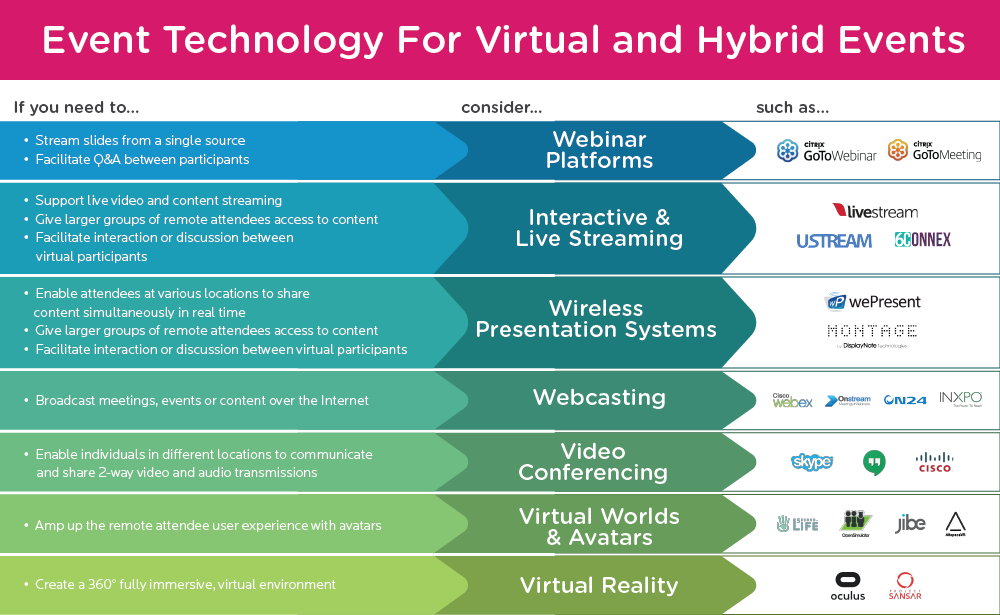What You Need to Know About Hosting a Virtual Meeting
In the corporate sector, organizations are exploring the trend towards virtual meetings and hybrid events to:
- address issues involving remote locations on a “just-in-time” basis
- reduce the time employees spend off the job for meetings
- trim travel expenses
- find alternatives in view of currency exchange differentials between some destinations
Associations use hybrid conferences as a strategy to provide a wider audience with access to content and spark interest in future live conferences.
What is a virtual meeting?
Participants from various locations communicate and interact directly with each other and the speakers.
- Cisco’s groundbreaking 2009 Global Sales Experience (GSX), at which 19,000 members of the Cisco sales team attended virtually through Telepresence.
- Chalifour Canada recently produced Virtuo, the world’s largest virtual trade show, using Communique Software.
What is a hybrid event?
Hybrid events combine face-to-face events with virtual access for remote participants.
- GSX 2010, which involved 21,000 participants, incorporated interactive gamification to boost engagement.
- MPI’s WEC 2010 included a virtual conference room for remote participants. Michael McCurry wrote about lessons learned.
- The recent collaborative [CTRL] + [ALT] + [DEL] became a game changer by adding remote face-to-face pop-up event locations around the globe.
What are the benefits of virtual meetings and hybrid events?
- access from just about any point of the globe
- access to great content without incurring travel, accommodation, or food and beverage costs
Of course, due to their dependence on technology, these events do present some unique challenges. You need to make sure that:
- all presenters are clearly seen and heard
- there is sufficient bandwidth to give all participants access
- all participants can ask questions and interact with speakers
- virtual and remote participants can interact with each other
Fortunately, emerging technology is making it easier to deliver interactive and engaging experiences. And on that note, here are 8 things you need to consider when planning a virtual event or hybrid event.
8 Important Considerations when Planning a Virtual Meeting or Hybrid Event

1. Objectives: Ask “Why virtual?” and “What do you want to achieve?”.
Depending on whether the goal is to educate, entertain, or engage, this will guide your technology decisions and the choice of platform.
2. Type of Content: What type of content will be shared during the meeting? How many presenters will be sharing it?
Slides and a single speaker can be accommodated through webcasts but video requires technology that is capable of handling live streaming if there are multiple presenters.
3. Internet Bandwidth: How much is enough is always the question?
Rich video requires more bandwidth or the stream will be choppy.
- Know a venue’s bandwidth availabilities and who manages it before booking the event.
- Understand what is meant by shared/dedicated bandwidth.
- Verify the bandwidth you are getting by checking available speed against what has been promised with verification sites like www.speedtest.net and www. speakeasy.net/speedtest.
4. Engagement: How will you keep people engaged?
Virtual participants often multi-task and they have distractions and competing priorities. The level of commitment is low and they will drop off if they are not engaged. For this reason, the sound bites and presentation segments need to be shorter than for face-to-face meetings and events.
5. Speaker-to-Attendee Interactions: How much interaction is required between the speaker and the remote audience?
This is another key driver when selecting a platform. Is Q & A enough or do you require a platform that offers more robust discussion functionality?
To enable remote attendees to interact with the speaker and content just as though they were there in person, you can choose an event app with audience response functionality. Features include Live Polling, Surveys and Q & A. This makes it possible for attendees to submit questions during the meeting, participate in polls, and provide feedback.
6. Attendee-to-Attendee Engagement: How can you facilitate interactions between virtual and live participants?
Choosing an event app with interactive features like discussion channels can help spark conversations and facilitate networking between live and remote participants. Curious to hear more? Here are some ideas on could use Group Discussions at your next hybrid or virtual event.
7. Demographics: What is the age group, level of tech savvy, and multi-cultural mix of the audience?
This will influence decisions about the best platform, graphics, music, and use of avatars vs real people. Never make assumptions or base decisions solely on demographics. Use demographics as a starting point and then interview or poll a part of your audience to crowdsource you content and approach.
8. AV Considerations: What type of AV will be required to achieve your objectives?
Here Midori Connolly–Chief AVGirl of AVGirl Productions–reviews important AV considerations for hybrid events and tells us why it’s important .
What’s Next?
- Do you know if your corporate incentive travel program is working? Here’s how figure out if it’s a hit or a miss.
- User conferences are an incredible opportunity to develop deeper relationships with your customers. Here’s how to get the most out of user conferences.
- Consider leveraging the usefulness of a Hybrid Event Platform or of a Virtual Event Software.